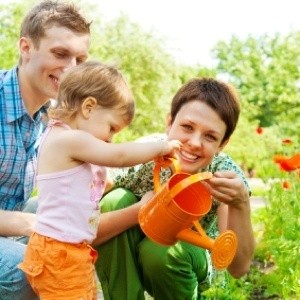
Whether it was from a parent, a grandparent, a neighbor, or even a teacher, people who garden as adults were usually exposed to the positive aspects of gardening when they were children. Studies show that children, no matter how small, can benefit socially, physically, and academically from participating in gardening. Here are some helpful tips for getting (and keeping) small children engaged in gardening.
It's easy to see how gardening teaches children patience, responsibility, nurturing, and gives them a sense of pride in their accomplishments. According to the National Garden Association, gardening affects children in even more surprising ways. Research shows that children who have access to gardens in their classrooms:
So what about children too young to be in school? They benefit by gardening, too. We all know that a child's early years are a crucial time of mental, physical, social, and emotional development, and that educational experiences during these first years significantly influence the rest of their lives.
With small children, go with the motto "Simple is Best." They have an extremely short attention span and need constant supervision. Keep the space where kids engage in gardening small (e.g. a paper cup, a small window box, or part of a row). Have a few simple activities planned ahead of time (digging for worms, planting seeds, picking flowers) and be prepared to swap them around according to the child's mood.
As children develop in age, so do their imaginations (think tree-forts, fairies, and secret gardens). Let them act out garden dramas through creative play. For example, the life cycle of a butterfly might be acted out through a dance, or by painting a picture or by making up a silly song.
Young children learn best though repetition and practice. When teaching them new gardening skills (like how to use a watering can or how to plant seeds), avoid criticizing and over-correcting them. Instead, teach with encouragement and enthusiasm. Then give them plenty of time and space to practice under more relaxed standards (e.g. don't worry about them planting perfectly straight rows).
Small children develop dexterity and hand-eye coordination at different rates. Struggling with small seeds or heavy bags of soil can make their time in the garden frustrating. To help build their self-confidence, keep tools and supplies size-appropriate to the task (e.g. a small watering can or large seeds for planting).
As early as age 4-5, children begin to show pride and concern about their possessions. They may still delight in flinging dirt and digging up worms (who doesn't?), but they also appreciate having some garden space of their own-especially one with a marker or sign that announces it is their garden. Children this age are discovering their independence and can be left alone (but within site) to conduct their own activities.
The most important thing to remember when gardening with small children is to keep things fun. Let the kids take the lead and if the opportunity presents itself, you can use the moment to fill in the rest of the story (e.g. explain how a seed grows into a plant while the child is covering seeds with dirt).
For more ideas on gardening with kids and information on how to get a gardening program started at your school, visit: www.kidsgardening.org

About The Author: Ellen Brown is an environmental writer and photographer and the owner of Sustainable Media, an environmental media company that specializes in helping businesses and organizations promote eco-friendly products and services.
Add your voice! Click below to comment. ThriftyFun is powered by your wisdom!
What a great article. I've been gardening with my daughters forever and they really have an appreciation for nature and can tell you the differences between different flowers and shrubs.
Add your voice! Click below to comment. ThriftyFun is powered by your wisdom!